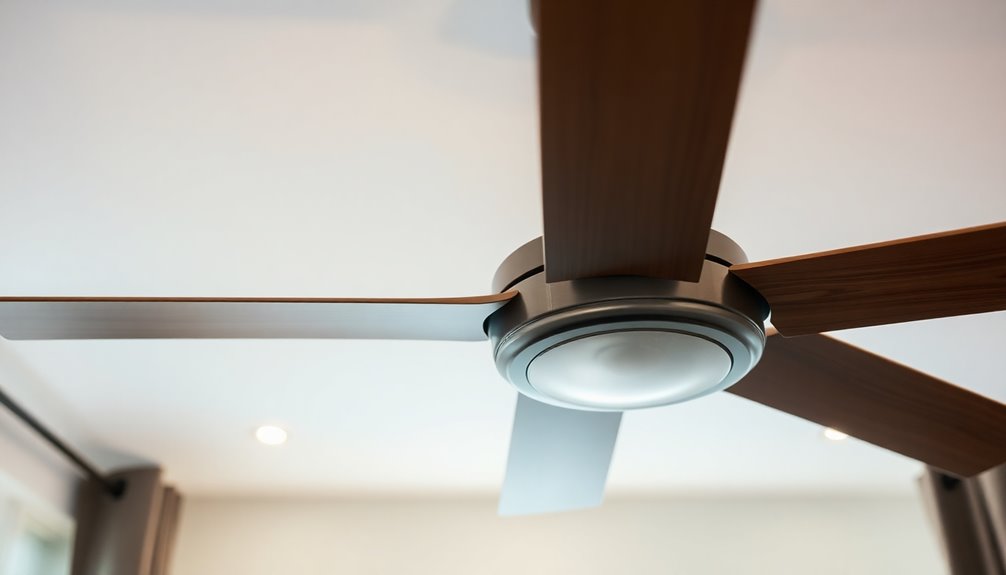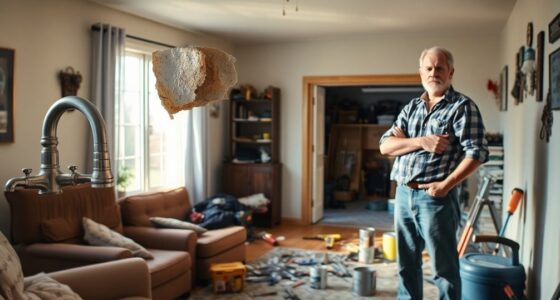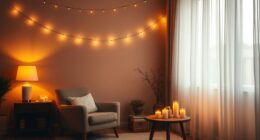If your ceiling fan is rotating in reverse, there are a few common reasons behind it. A malfunctioning direction switch might have been accidentally toggled or is defective. Incorrect wiring connections can also lead to unintended rotation. In some cases, mechanical issues can cause reversible motors to spin the wrong way. Regular maintenance is crucial too; loose wires or debris might obstruct the motor's function. To guarantee your fan runs smoothly, it's important to check these factors regularly. Keep exploring to uncover more insights on how to fix and maintain your ceiling fan effectively.
Key Takeaways
- A malfunctioning direction switch may be toggled incorrectly or defective, causing the fan to reverse direction unexpectedly.
- Incorrect wiring connections in the ceiling fan can lead to unintended reverse rotation.
- Insufficient back EMF from mechanical issues may cause reversible motors to automatically reverse.
- Regular maintenance is crucial; loose wires or debris can obstruct the motor and affect rotation.
- Voltage fluctuations and phase connection issues can disrupt the intended rotation direction of the fan.
Understanding Ceiling Fan Mechanics

When you understand how ceiling fans work, you can make better decisions about their use and maintenance.
Most ceiling fans use split-phase motors with capacitors to change rotation direction, allowing you to adjust airflow for seasonal use. The direction switch on your fan plays an essential role, letting you set the fan to push warm air down in winter or circulate cool air in summer.
However, wiring issues or a faulty direction switch can lead to unexpected rotation, causing your fan to spin in reverse.
Modern ceiling fans often feature efficient DC motors, enhancing performance and energy savings.
Common Causes of Reverse Rotation

Reverse rotation in ceiling fans can be frustrating, especially if you're unaware of what's causing it. One common culprit is a malfunctioning direction switch, which might've been accidentally toggled or could be defective.
Incorrect wiring connections during installation can also lead to your ceiling fan reversing its intended rotation direction. If your fan has a reversible motor, it may automatically reverse when it detects insufficient back EMF, often due to mechanical issues.
Regular maintenance is essential; loose wires or debris can obstruct the motor and cause unexpected behavior. Additionally, some older models use a pull-chain switch that can be mistakenly pulled, resulting in an unintended change in rotation direction.
Stay vigilant to keep your fan running smoothly!
Importance of Proper Wiring

Proper wiring is essential for ceiling fan performance, as it directly affects how well the fan operates and whether it rotates in the intended direction. If you have improper connections, your ceiling fan might rotate incorrectly, leading to poor airflow and operational issues.
Many fans feature a two-direction switch, and it's vital that the wiring is connected correctly to achieve the desired airflow direction. Don't overlook junction boxes, as they may conceal unused direction wires that need inspection.
Poorly wired fans can cause excessive motor strain, resulting in early failure or even safety hazards. Regularly checking your wiring and connections can help guarantee your fan runs effectively in both summer and winter modes, enhancing your comfort and safety.
Power Supply Considerations

When it comes to your ceiling fan, understanding phase connection issues and voltage fluctuations is key.
If the power supply isn't compatible, you might find your fan spinning the wrong way or not working at all.
Regularly checking these aspects can help guarantee peak performance and comfort in your space.
Phase Connection Issues
If you've ever noticed your ceiling fan spinning in the opposite direction, it might be due to phase connection issues in the power supply.
Ceiling fans typically operate on single-phase power, and incorrect phase connections can cause reverse rotation. This is especially common if line connections are interchanged during installation or maintenance.
Wiring issues within the junction box can also play a role; if unused direction wires are improperly connected, your fan may not rotate as intended.
Since AC motors rely on proper phase alignment, understanding your local electrical configuration is essential.
To prevent these problems, double-check your installation and verify the phase connections are aligned correctly for smooth operation.
Voltage Fluctuations Impact
Incorrect phase connections aren't the only issues that can affect your ceiling fan's performance; voltage fluctuations in the power supply also play a significant role.
When your ceiling fan experiences inconsistent voltage levels, it can disrupt the intended direction of rotation, potentially causing reverse rotation. In single-phase AC systems, improper phase shifts arise from these fluctuations, impacting motor function.
Capacitors in the fan's motor are sensitive to voltage changes, and insufficient voltage may fail to provide the necessary phase shift. Additionally, power supply issues like surges can interfere with back EMF detection, leading to unexpected rotation behaviors.
Regular maintenance and monitoring of your electrical supply are essential for preventing voltage-related problems that may cause your ceiling fan to operate incorrectly.
Troubleshooting Direction Issues

How can you effectively troubleshoot direction issues with your ceiling fan? Start by checking the direction switch, as a malfunctioning switch mightn't engage the desired motor direction.
If your fan has a reversible motor, it might rotate randomly until it detects back EMF, so be patient while it stabilizes. Additionally, inspect for wiring issues, like incorrect connections or damaged wires, which can cause unexpected direction changes.
User feedback often suggests that jogging the reverse switch helps stabilize inconsistent operation. Regular maintenance and inspections are important; they guarantee all components are functioning correctly, preventing direction-related problems from arising.
Seasonal Fan Direction Guidelines
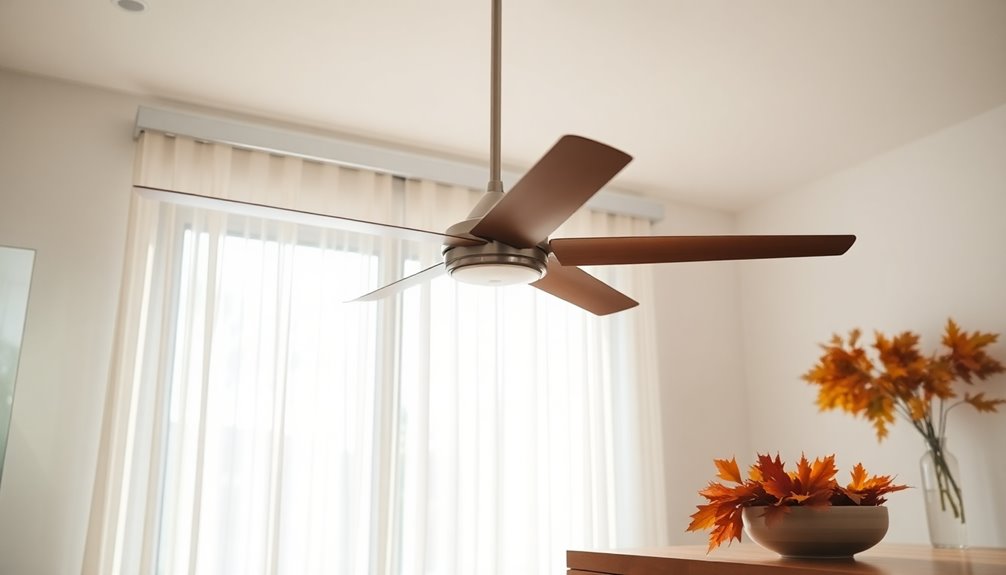
To optimize your ceiling fan's performance throughout the year, it's crucial to understand the appropriate rotation direction for each season.
Here are three key seasonal adjustments you should make:
- Summer: Set your ceiling fan to rotate counterclockwise to create a rejuvenating cooling breeze that enhances the wind-chill effect.
- Winter: Change the rotation direction to clockwise at low speed; this helps pull cool air up and redistributes warm air that rises to the ceiling.
- Energy Savings: Proper airflow direction can lead to up to 30% savings on heating and cooling costs.
Utilizing the reverse switch for these seasonal adjustments guarantees maximum comfort and efficiency in your home.
Don't forget to regularly check and adjust your fan settings!
Adjusting Your Ceiling Fan Correctly
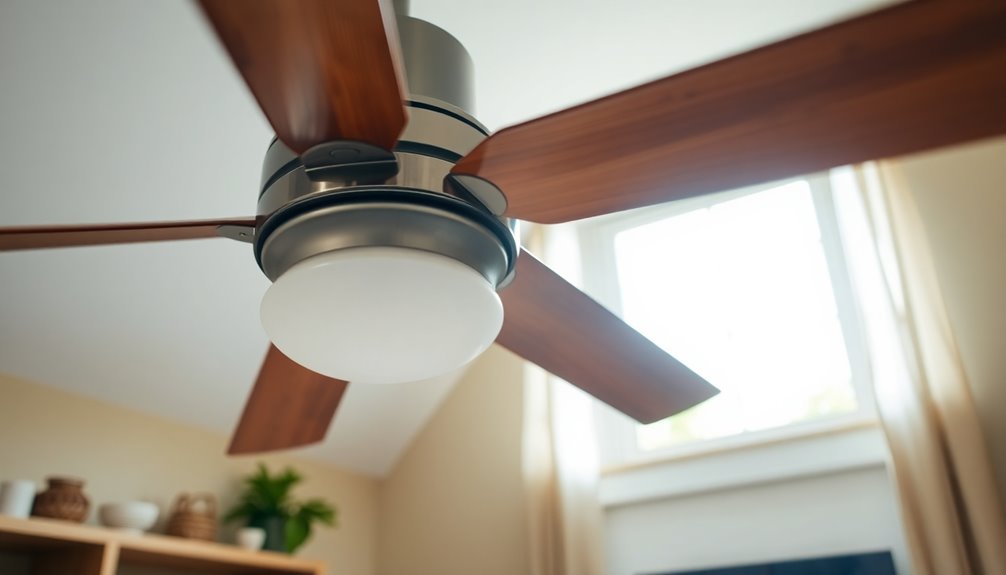
Adjusting your ceiling fan correctly can make a noticeable difference in your comfort level throughout the year.
Start by locating the reverse switch, which allows you to change the fan's rotation direction for seasonal use. In summer, set the fan to rotate counterclockwise to create a cooling breeze that enhances the wind-chill effect.
For winter, switch it to rotate clockwise at a low speed to circulate warm air that collects near the ceiling back down into your living space.
Many modern ceiling fans include remote controls that make this adjustment easier. Additionally, using energy-efficient motors can enhance the fan's performance while reducing electricity bills.
Remember to turn off the fan before changing the direction to guarantee safety and proper operation.
Following these steps can greatly improve your indoor climate.
Frequently Asked Questions
Why Is the Fan Suddenly Rotating in the Wrong Direction?
If your fan's suddenly rotating in the wrong direction, it might be due to a few reasons.
First, you could've accidentally flipped the reverse switch during use.
Another possibility is a malfunctioning switch that's causing erratic behavior.
Wiring issues, like loose connections, can also lead to improper operation.
Regularly checking the fan's components can help you avoid these unexpected changes and keep your fan running smoothly in the intended direction.
How to Fix a Ceiling Fan Spinning Backwards?
So, your ceiling fan thinks it's in a dance-off, spinning backwards? Don't worry, you can fix it!
First, check the reverse switch on the motor or remote—flipping it might do the trick. If that doesn't work, inspect the wiring connections to verify they're correct.
Test the fan by turning it off and on again. Regular maintenance, like cleaning, can also help prevent these unexpected moves.
You've got this!
Why Does the Ceiling Fan Go in Reverse?
Your ceiling fan goes in reverse due to a dedicated reverse switch that changes the motor's wiring configuration.
When you flip this switch, it allows the fan to either push cool air down during summer or pull warm air up in winter.
If your fan's direction changes unexpectedly, it could be a sign of a faulty switch.
Regular maintenance guarantees everything runs smoothly, so keep an eye on that switch for proper functionality!
Why Does My Fan Spin Counterclockwise?
When your fan spins counterclockwise, you're enjoying a revitalizing breeze, enhancing comfort, and maximizing air circulation.
This rotation pushes air down, creating a wind-chill effect that makes you feel cooler, even if the room temperature stays the same.
You'll find it ideal for hot summer days, as it helps reduce your reliance on air conditioning, ultimately lowering your energy bills.
Conclusion
To sum up, understanding why your ceiling fan rotates in reverse can enhance your comfort and energy efficiency. Curiously, studies show that running a ceiling fan in the correct direction can save you up to 30% on cooling costs during the summer months. By ensuring proper wiring and making necessary adjustments, you can enjoy the ideal airflow and temperature in your space. So, take the time to check your fan's direction—your wallet will thank you!
